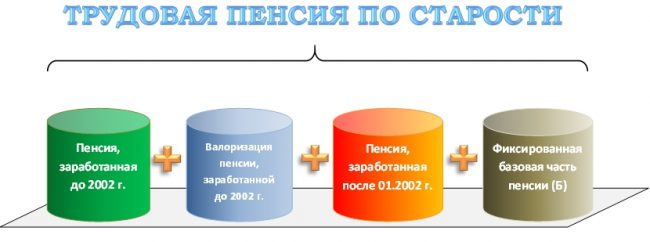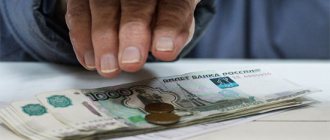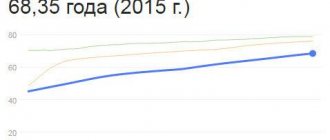Humanity is rapidly aging; out of the total number of inhabitants of our planet, there are a billion people of retirement age. This is every sixth person. If we talk about Russia, then every fourth resident is a pensioner. Have you ever thought about what old age, life expectancy, or retirement mean?
Old age can be compared to the autumn of life - colors have faded, events of the past emerge in memory. When you are young and full of strength, it all seems so distant, illusory. But time spares no one - year after year, you are already thirty, forty, fifty years old. What seemed so far away becomes very close and tangible. Unfortunately, everyone has the same ending - a well-deserved rest. In the article you will learn what a pension and the survival period are. How are deadlines calculated? What is the savings part? What will be the payment amount? Who are the “early-term workers”?
Pension provision
A pension is a permanent cash payment that is provided on a regular basis to persons with a certain social status. Regular guaranteed salary is paid to the following categories:
- People who have lived to a certain age receive an old-age pension.
- People who have serious health problems since birth, as well as those who have suffered injuries and injuries that do not allow them to fully carry out work, are issued a disability pension.
- For minors, in case of loss of parents or guardians (death, etc.) - issued in connection with the loss of a breadwinner.
Pension payments are of two types:
- State guaranteed payments.
- Private (implemented by private pension funds).
The assigned pension payments are of an indefinite nature.

Required experience and coefficient for registration
To receive an insurance pension, a citizen must have at least 10 years of work experience. This figure will increase from 2019 to 2024 until it reaches 15 years. The insurance period is determined depending on the number of years worked, which are reflected in the individual accounting information. The last accounting date is the day you contact the fund to process payments.
To receive insurance payment, you will need to provide proof of work experience using a work book and certificates from employers. In some cases, citizens have to prove their experience in court, since the Pension Fund of the Russian Federation does not agree to take into account the time worked.

The length of service takes into account not only the time that was directly worked, but also some other periods of life.
Total work experience is accumulated in the following cases:
- dependent care;
- Military service;
- child care up to one and a half years old;
- time spent by military wives in closed areas;
- unemployment with benefits;
- serving a sentence in correctional institutions if the person turns out to be innocent.
The reform entails an increase in the required minimum pension coefficient. If in 2020 it is 16.2, then in 2020 it should be 18.6. The individual coefficient reflects the amount of funds transferred to the Pension Fund for the period of work and other types of work experience. The indicator directly affects the size of the final payment.
To start receiving contributions, a citizen must submit a corresponding application to the Pension Fund. To accept it, you must meet the conditions set at the state level. A person has the right to apply immediately upon reaching the required age or later.
How is length of service and salary reflected when calculating the amount of an old-age retirement pension?
The current law was adopted at the end of 2001 . People who are currently retiring due to old age have work experience both before this date (total length of service) and after it (insurance period). Therefore, the pension is calculated over two periods.
Be sure to read it! Insurance payment in case of an accident: how to get compensation according to the law in 2020?
For the period before 2002 , it is calculated according to the previous law, using a formula that takes into account length of service and wages. And for the period starting from 2002 , the calculation directly includes the amount of insurance premiums paid by the employer. They are paid to the Pension Fund for each employee and amounted to 12% before 2005 , 14% before 2010 , and now - 16% of wages for men and women born in 1966
Estimated survival times
The term was approved by Decree of the Government of the Russian Federation No. 531 in 2015. The indicator is subject to annual adjustments, based on data from the Federal State Statistics Service. The calculation of the survival period is carried out by the state executive body - the Government of the Russian Federation. The data is processed, and as a result, the average period of a person’s life in retirement is calculated. The indicator is usually calculated in months. The survival periods of the male and female parts of the population of the Russian Federation differ in terms of timing. Women have more, men have less.

Technology for calculating survival time
During the 2020 pension reform, the Cabinet of Ministers adopted Resolution No. 531, which approved the technology for calculating mandatory payments to older people. To calculate the pension, the survival period is set according to a certain formula. It looks like this:
- T = (Si × ei + Sj + ej / Si × Sj) × 12.
This technique requires detailed explanation. Each symbol has a certain meaning:
- The symbol T indicates the estimated period for which the transfers are expected to take place (expected payment period). The unit of measurement is one month.
- Symbols Si - indicate the size of the male population who have reached the age of sixty.
- Symbols Sj - indicate the female part of the population, whose age is fifty-five years.
- The symbols ei indicate the expected life span of the male half of the population.
- The symbols ej indicate the expected life span of the female half of the population.
Data are provided by statistics and accounting authorities.
Features of the process before approving the survival period
There are some features that apply during the annual recalculation of the survival period. Before the annual approval of the updated deadlines, a comparison is made with current indicators. This procedure looks like this:
- In the event that the updated indicators are higher than the current values, the maximum current indicator for the outgoing year is approved.
- If the indicators are below the high point of the outgoing year, but above the established limits last year, then the period is accepted in the calculated (updated) amount.
- When the indicators are below the high point of the outgoing year, but not higher than the established limits for the previous reporting period, then the period is approved in the maximum amount that was determined for the past year.

Accumulative pension payments
Before we figure out how the funded pension and the survival period are related, let's talk about what such a payment means? These are funds that are accumulated into a single whole by adding employer contributions and income received from investing the collected amount. Monthly transfers by the employer for a legally employed person are equal to 22%, the share of the funded part is 6%. It is these two amounts that make up the savings in question.
How are payments made? The scheme looks quite simple:
- At the time of retirement, the collected amount begins to be transferred monthly along with the main pension payments. Simply put, it is an additional supplement to the mandatory part of the pension.
- The monthly paid portion is calculated using a formula. When making calculations, the expected payment period also plays a significant role.

How is OPV calculated?
In 2020, the calculation of a funded pension is regulated by the Federal Law “On the expected period of payment of a funded pension for 2020” dated December 28, 2016 No. 481-FZ, and the methodology for determining the CPV is approved by the Decree of the Government of the Russian Federation “On approval of the methodology for assessing the expected period of payment of a funded pension” dated 02.06 .2015 No. 531. According to regulations, OPV is calculated using the formula:
T = ((Sixei + Sjxej) / (Si + Sj)) x 12 , where
T – the required value of OPV, months;
Si – the number of men who have crossed the 60-year-old threshold, according to information from the Social Insurance Fund;
Sj – number of women who have reached their 55th birthday;
ei – predicted life expectancy of retired men;
ej is the predicted life expectancy of women applying for pension payments.
However, the value obtained in this way is not always accepted as final. For example, according to calculations using the above formula, the OPV of NP in 2020 should be 261 months. Considering the fact that in 2020 this figure was 234, the jump between the OPV values is too large. To avoid a sharp increase in the calculated indicator, the Government introduced restrictions covering the period from 2016 to 2020. The maximum values for the expected payment period of the accumulative security for 2016-2020 are reflected in the table below.
Permissible maximum OPV NP for 2016-2020:
| Year | Maximum size of OPV NP, months |
| 2016 | 234 |
| 2017 | 240 |
| 2018 | 246 |
| 2019 | 252 |
| 2020 | 258 |
As can be seen from the table, for a uniform progressive increase in the value of OPV, six months are added to the value of the indicator annually.
The real value of OPV NP is 21 months longer than established at the legislative level and amounts to almost 22 years. If the calculated figure had been accepted, i.e. 261 months, then the amount of monthly funded pension payments would have decreased. This is clearly demonstrated by the formula used to determine the amount of payments:
NP = PN / T , where
NP – monthly payment amount;
PN – amount accumulated during active work;
T is the value of OPV NP, which in 2020 is 240.

If you retire later
If a citizen who has reached retirement age applies for payments not immediately, but after a certain period of time, he can count on an increase in the amount of payments due to a decrease in the value of T. In this case, each deferred year reduces the OPV NP by 12, which means every year the amount of payments due will increase. However, the T value can only be reduced to 168 months - this is the minimum established by the Federal Law “On Savings Pensions” dated December 28, 2013 No. 424-FZ.
Calculation example. Citizen Ivanov, born in 1957, applied for the accrual of NP payments to him in 2017, i.e., after turning 60 years of age. At the same time, during his working career he accumulated 300 thousand rubles. In this case, the monthly payment amounted to 1,250 rubles. This figure was obtained by simply dividing the accumulated amount by the OPV value in 2020: 300,000/240=1250. If Ivanov applied for payments in 2020, the amount of accruals would be 1,351 rubles, provided that since 2020 the amount of savings has remained unchanged. How did this figure come about? In 2020, the OPV NP will be equal to 258. Since the citizen applied for a pension three years after his 60th birthday, 36 is subtracted from 258 and the value T = 222, and then 300,000/222 = 1351. This value could be even greater if the pensioner continued to work and increase the amount of savings during these three years.
Knowing his amount of savings, a pensioner can easily determine the amount of payments due to him.
Calculation method, specific amount and choice
The formula and final payout amount is calculated as follows:
- PEP = NPP + PD (or OPV);
Where:
- PEP – constant monthly payments;
- NPF – accumulated pension funds (funded part);
- PD – survival period (expected period of payments).
Let’s say the funded part of the funds at the time of retirement is 50,000 rubles. In this case, the calculation will look like this:
- 50 000 / 246 = 203,25
The amount of the monthly supplement will be 203 rubles 25 kopecks. How the expected period is calculated is described above.
The law also provides for the following types of receipt of the funded portion:
- One-time receipt. It is possible to pay the amount in full.
- Urgent receipt. The deadline is set by the pensioner, but not less than ten years.
- Standard savings payments calculated according to an approved formula.

Expected pension payment period in 2020: current value
The expected pension payment period in 2020 is 252 months. This indicator changes annually.
Definition of the expected period
The expected duration of provision is considered as the time during which the state will pay old-age benefits to citizens. It is also referred to as the survival time period. This is the period that lasts from the moment a person is assigned a pension until his death.
This indicator is calculated as an average. The calculation is made every year. In this case, the average statistical data for the country on the life expectancy of citizens is taken into account. Currently it has increased by six months .
How did survival times change?
The expected pension payment period until the end of 2020 was a constant indicator. This suggests that the changes did not affect him. The value was 228 months, that is, 19 years. Since the beginning of 2020, the indicator in question has been adjusted annually.
The current amount is reflected in Federal Law No. 424 of 2013 “On funded pensions”.
The level of survival is influenced by the life expectancy of persons who have retired. The table of expected pension payment ages is presented below.
YearTerm of funds transfer
| 2015 | 19 years (228 months) |
| 2016 | 19.5 years (234 months) |
| 2017 | 20 years (240 months) |
| 2018 | 20.5 years (246 months) |
| 2019 | 21 years (252 months) |
| 2020 | 21.5 years (258 months) |
Every year this value is analyzed, on the basis of which changes are made to the law. In 2020, the period became 246 months.
Since that time, the indicator in question has been constantly increasing. Statistics indicate that the length of time during which the population receives benefits is increasing.
This argument was used to raise the age category at which a person gains the right to retire. In addition, this affects the duration of receipt of pension contributions.
Survival time in 2020
At the end of 2020, Federal Law No. 476 “On the expected period of payment of funded pensions for 2020” was published. This act establishes what indicator will be used to assign benefits.
Now it is equal to 252 months, that is, 21 years. Compared to last year, the figure increased by six months. In this law, the value is reflected only for 2019. This suggests that a different meaning will be used in 2020.
What does the expected period affect?
The duration of the time period under consideration is taken into account in the formula used to calculate the cumulative component.
This formula is presented:
NP = P/T , where
- NP – benefit amount;
- P – pensioner’s savings;
- T – the time during which it is planned to transfer old-age security to the person.
The citizen’s savings are stored in his account. It can be pension or personal. Such funds are used to form savings.
When studying the formula, it is clear that when the indicator under consideration increases, the value of the cumulative part decreases.
An example of calculating a pension taking into account the expected survival period
It is better to consider the expected period of payment of a funded pension using a specific example. At the time of receiving the right to retire, the citizen had accumulated 260,000 rubles in his account.
For contrast, in the first case of calculation, you need to use the indicator of the expected period for 2020. It was 240 months. The 2020 value of 252 also applies.
The calculation looks like this:
- for 2020: 260000/240 = 1083 rubles;
- in 2020: 260000/252 = 1031 rubles.
The specified amount is added to the monthly payment. A person may apply for a pension later than he has such a right. Then the benefit will be greater.
The rule applies is that the survival time is reduced by 12 for each full year during which the person did not apply for the money due to him.
An example of a shortened survival period
The citizen received the right to retire in March 2020. He decided not to immediately contact the Pension Fund to assign benefits. The appeal will take place in 2021. Then the indicator is reduced by 24 units.
This amount is obtained by multiplying 12 by 2, since a full 2 years will be missed. It is worth considering that there is a limit on the length of the period. It cannot be less than 168 months. This rule was established in 2020.
In the example under consideration, you will need to divide the citizen’s savings by 228. Until 2020, a similar indicator was used to calculate labor benefits.
After the entry into force of Federal Law No. 400 of 2013 “On Insurance Pensions,” the concept of labor amounts is not used, they are replaced by insurance ones.
The amount of the benefit depends on the IPC and production.
What to do to ensure that the amount of monthly payments does not decrease
According to the reform program, a citizen’s savings, which depend on his length of service, should only grow in size. The fact that survival time will increase in the future cannot be considered as a way to reduce the burden on the Pension Fund. This is the real state of affairs.
The increase in the expected benefit period in 2020 will not affect the amount of one-time benefits for retirees.
The following are entitled to receive such benefits:
- persons who are not paid old-age pensions (the reason for this may be the lack of the required level of output or the fact that not enough IPC has been accumulated);
- citizens receiving support from the state due to loss of ability to work, loss of a breadwinner;
- those who have accumulated 5% or less of the total amount of old-age insurance accruals in the account (this figure includes fixed charges and benefits).
A lump sum payment is understood as a one-time release of funds. The citizen is transferred the money accumulated during his working life.
How will increasing the expected period affect term payments?
An increase in the survival rate may not affect the amount of urgent payments for the population. Urgent benefits are understood as monthly income due to citizens who have retired.
A limitation has been established on the duration of the time period during which security from the state is required. It cannot be less than 10 years.
Only those persons who took part in the co-financing program can receive this type of benefit. It is implemented by the state. Not only individuals, but also employing companies can participate.
Citizens whose payments are formed using family capital also have the right to these pensions.
What does the Pension Fund plan in the future regarding the survival period?
The expected period may not currently apply to a particular category of recipient. Reform in the field of state support for persons who have retired will be carried out systematically.
Completion of innovations is scheduled for 2024. Lawmakers plan to increase the survival rate to 320 months. This change entails that the amount of pension income will be reduced.
The new system encourages later retirement. This will allow you to receive an increased amount.
Thus, survival time must be used when calculating benefits. This figure is increasing every year. This entails a reduction in the amount of payments.
Source: https://ProPensiu.ru/raschet-pensii/ozhidaemyj-period-vyplaty-pensii-aktualnoe-znachenie
Category "early term"
The pension legislation of the Russian Federation provides for the possibility of early retirement. The survival period for “early term recipients” differs from the generally accepted one. The category is divided into two lists, numbered 1 and 2. Starting in 2013, the period rises annually by twelve months. From the first list, the survival period is: from 2016 - 24 years, for the second list from 2021 - 29 years.
The reasons for this retirement are:
- Difficult working conditions (for example, working in a mine or hot shop).
- Harsh climatic conditions (work in the Arctic or Far North).
- A number of specific professions (ballerinas, rescuers, etc.) fall under this category.
- This also includes residents of regions exposed to radioactive contamination who have the appropriate status.
Citizens are divided into two main categories that give them the right to early exit:
- five years earlier;
- ten years earlier.
If such citizens do not stop legal work, then an additional preference is provided for them - a bonus for length of service. All other calculations follow the general formula. The complete lists of beneficiaries can be found on the website of the Pension Fund of the Russian Federation.
PFR table of the expected period of payment of a funded pension in 2020
A letter to confirm your subscription has been sent to the e-mail you specified.
January 11, 2019
To assign a funded pension in the State Pension Fund of Russia, there are two factors: a person must have the right to receive an insurance pension and have funds for pension savings. Changes in pension legislation that entered into force on January 1, 2020 do not change the rules for assigning and paying pension savings.
The retirement age giving the right to receive them remains the same – 55 years for women and 60 years for men. This applies to all types of pension payments, including funded pensions, fixed-term and lump-sum payments.
As before, pension savings are assigned based on the minimum required pension points and length of service: in 2020, these are 16.2 points and 10 years, respectively.
You can apply for a funded pension at any time after the right to it arises without any time restrictions; payment can be assigned either simultaneously with the insurance pension or separately.
If the pensioner whose pension savings were formed did not apply for their establishment, then he can apply for the establishment of the appropriate payment at any time convenient for him.
It does not matter whether the pensioner is working or not working.
Pension savings are formed mainly from insurance contributions that employers paid for their employees until 2014. The receipt of new employer contributions to pension savings in the compulsory pension system was suspended by decision of the state for the period 2014–2019.
However, until the end of 2020, citizens whose pensions were accumulated in this way were given the right to choose: to direct the entire amount of the employer’s insurance contributions to the formation of an insurance pension or to distribute them between insurance and funded pensions.
This opportunity is still available to those who have just entered into an employment relationship and contributions for them first began to be received after January 1, 2014.
Who has pension savings:
- for working citizens born in 1967 and younger due to the fact that their employers pay insurance contributions to finance the funded pension;
- for men born in 1953–1966 and women born in 1957–1966, in whose favor employers paid insurance contributions for the funded part of their labor pension in the period from 2002 to 2004. Since 2005, these deductions have been discontinued due to changes in legislation;
- for participants in the State Pension Co-financing Program;
- those who allocated funds from maternal (family) capital to form a funded pension.
There are three types of pension savings payments:
Funded pension. Carried out monthly and for life. Its size is calculated based on the expected payment period: from 2019 - 21 years (252 months).
To calculate the monthly payment amount, the total amount of pension savings accounted for in the special part of the individual personal account of the insured person, as of the day from which the payment is assigned, must be divided by 252 months.
One-time payment. When all pension savings are paid out at once in one amount.
Recipients of such a payment are citizens whose funded pension is 5 percent or less in relation to the amount of the old-age insurance pension, including taking into account the fixed payment and the amount of the funded pension calculated as of the day the funded pension was assigned. Recipients of a one-time payment are also citizens receiving a disability or survivors' insurance pension, or receiving a state pension, who, upon reaching the generally established retirement age, have not acquired the right to an old-age insurance pension due to the lack of the required insurance period or the required amount pension points.
Urgent pension payment. Its duration is determined by the citizen himself, but it cannot be less than 10 years.
Paid upon the emergence of the right to an old-age pension to persons who have accumulated pension savings through contributions under the State Co-financing of Pensions Program, including employer contributions, state co-financing contributions and income from their investment, as well as from maternity (family) capital. and income from their investment.
The procedure for applying for a funded pension is as follows.
An application for the assignment of a funded pension or an urgent pension payment is submitted to the territorial body of the Pension Fund of Russia at the place of residence, place of stay or place of actual residence of the citizen, to the MFC or in the form of an electronic document through the “Personal Account of the Citizen” on the official website of the Pension Fund. The application can be submitted in person, through a legal representative by mail or through an employer.
You must have your passport and SNILS (certificate of compulsory pension insurance) with you.
An application for a funded pension or an urgent pension payment is considered no more than 10 working days from the date of receipt of the application with all the necessary documents.
An application for a lump sum payment is considered within a month from the date of submission of the last required document, submitted within three months from the date of receipt of the relevant clarifications from the territorial body of the Pension Fund.
Based on the results of the consideration, a decision is made to assign the appropriate payment or to refuse to assign it, with justification of the reasons.
A one-time payment of pension savings is made within a period not exceeding two months from the date of the decision.
Expected period for payment of pension savings
The funded pension is of unlimited duration and is paid to the pensioner along with insurance coverage every month until the end of the citizen's life . In this case, a special indicator is used in the calculation - the expected period of payment of funds .
In contrast to the calculation of term security, where the applicant independently chooses the period during which savings funds will be paid to him, this indicator is established annually by the state based on official data from Rosstat (Federal State Statistics Service).
This indicator is also called
“survival period” , since, according to statistics, it shows the average life expectancy of citizens after reaching retirement age. Its calculation is carried out according to a certain formula in accordance with a special methodology approved by the Government of the Russian Federation.
In addition, for this indicator at the legislative level there are certain restrictions in the form of maximum values . The legislation also allows for a reduction in the indicator if a citizen applies for the establishment of security later.
How is a funded pension calculated?
The source of funding is the amount of funds that have accumulated in a retirement savings account or in a special part of the insured person's personal account. When calculating it, the size of its monthly payments , which directly depends on the amount of accumulated funds and the expected period.
According to paragraph 2 of Article 7 of Federal Law No. 424-FZ of December 28, 2013, monthly security is determined by the following formula :
- NP - funded pension;
- PN - the amount of savings that were formed throughout the citizen’s life as a result of work, voluntary contributions and investment;
- T is the projected period during which it is planned to pay the funds (in months).
When calculating, the amount of savings in the account is taken into account at the time the pensioner applies to establish his security, and the expected survival period is established by the state and changes annually depending on the life expectancy of pensioners in Russia.
In addition, every year on August 1, the amount of funds is recalculated , as a result of which the amount can be adjusted by investing the savings reserve or previously unaccounted for income.
You can calculate your funded pension yourself. To do this, it is necessary to divide the amount of funds available in the pension savings account, current on the day of applying for security, by the number of months of the expected payment period.
What is the expected payment period?
The estimated period is a certain period of time , which is calculated based on data provided by the Federal State Statistics Service. This indicator depends on the average life expectancy of the population and is established annually by the Government of the Russian Federation.
Before the pension reform, as a result of which the labor pension was divided into two independent ones - insurance and funded, the estimated period was used when calculating the labor support of citizens. However, from January 1, 2020 to the present, this parameter is used only for calculating the savings provision .
Methodology for calculating the survival period
In accordance with Resolution No. 531 of June 2, 2020, the Government of the Russian Federation approved a methodology for calculating the expected survival period. This methodology is used when calculating the timing of the accrual of security for citizens and is calculated as follows:
- T - expected payment period (in months);
- Si is the number of men over 60 years of age;
- Sj is the number of women over 55 years of age;
- ei is the predicted survival time of male pensioners;
- ej is the predicted survival time of female pensioners.
The number of citizens of the corresponding age in the country, as well as their expected life expectancy, is determined on the basis of official statistics obtained from statistical bodies.
Also, the calculation of the indicator has its own characteristics. Before the estimated period for a given year is officially adopted, it is compared with the maximum values established at the legislative level. If the indicator value is:
- higher - it is set at the maximum value for a given year;
- below the maximum in a given year, but above the value established for the previous year - it is accepted in the calculated amount;
- below the maximum in a given year, but not higher than the value adopted last year - it is set in the amount of the maximum value of the past year.
Read also: Payment of the first pension
Maximum values in 2016-2020
According to Appendix of Resolution No. 531 of June 2, 2020, for 2016 - 2020, the maximum values for the expected payment period of the savings security were established:
The maximum values of the survival period are far from real indicators.
But the adoption of this measure was necessary to curb a sharp increase in the payment period, which could occur due to an increase in the number of citizens of retirement age.
It is assumed that an annual increase in the value by 6 months will provide recipients with a funded pension until it approaches real indicators in the future.
Expected pension payment period in 2020
According to statistics, the actual expected payment period in 2020 exceeded the maximum value and amounted to 261 months. In this regard, from January 1, 2020, this indicator was set at the maximum value - 246 months .
In other words, to calculate the monthly provision of a funded pension when applying for it in 2018 , you need to divide the amount of your pension savings in the account by 246.
Last year, 2020, the real indicator of the expected period also turned out to be higher than the maximum - 261 months. And also last year, in accordance with the legislation of the Russian Federation, it was adopted at the maximum established for 2020 - 240 months.
Thus, compared to last year, the expected payment period has increased by six months. It should also be noted that if the real indicator was established, the funded pension would be paid in a smaller amount, since the higher the value of the accepted expected payment period, the lower the monthly pension.
Reducing the payment period for late retirement
A citizen acquires the right to receive his pension savings when insurance coverage is established for him. However, it is not necessary to apply for them immediately after reaching retirement age; this can be done much later .
For each additional year that has elapsed since the acquisition of the right to assign funded security, the expected survival period is reduced by twelve months .
However, at the same time, paragraph 3 of Article 7 of Federal Law No. 424-FZ of December 28, 2013 provides a minimum threshold for the expected period - at least 168 months (14 years).
Due to the fact that with a later application the indicator of the expected survival period will be less, the amount of pension savings will no longer be divided by the period established by the Government, but by the indicator that relates directly to the given citizen (at least 168 months). In this case, when calculating, the monthly funded pension will be higher.
Thus, thanks to a later application for the establishment of accumulative security, the expected payment period is reduced and, accordingly, the monthly payment increases, which, after its accrual, will be paid in an increased amount. This measure encourages citizens of retirement age to apply for assignment of their security later.
Source: https://zakon-jurist.ru/vyplaty/pfr-tablitsa-velichiny-ozhidaemogo-perioda-vyplaty-nakopitelnoj-pensii-v-2019-godu.html
Expected payment period for 2020
The survival period in Russia for this period is determined at 246 months. Based on data from the State Statistics Service, we can say that the indicators for the past 2020 exceeded the established maximum and were at 261 months. Accordingly, the maximum level was determined. Therefore, in the current year, the figure for calculation using the formula is 246. In dry language, the current period has increased by six months compared to the previous period.











